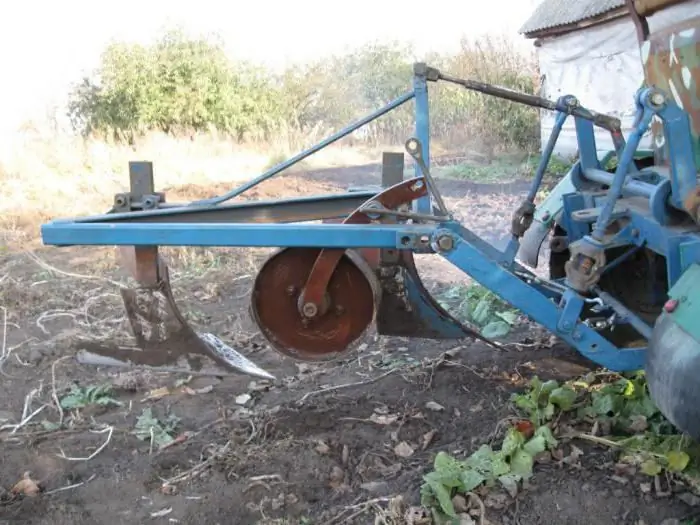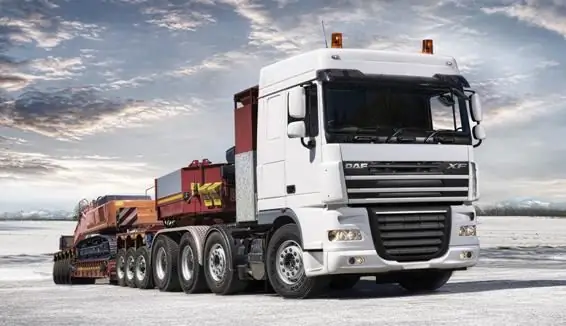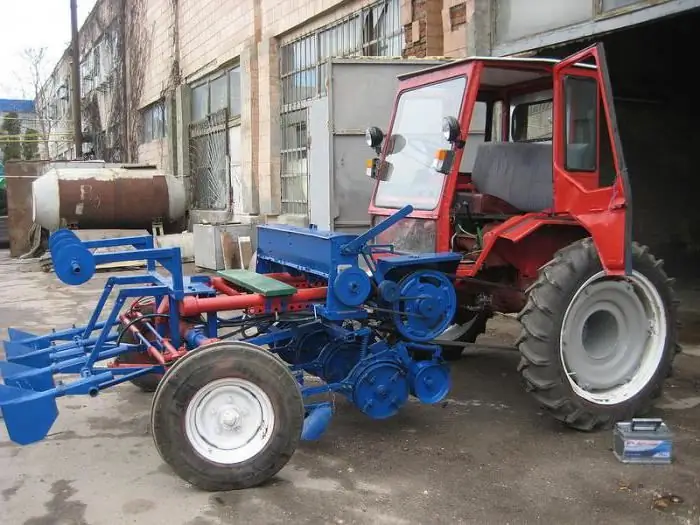2026 Author: Erin Ralphs | [email protected]. Last modified: 2025-01-22 21:14:13
One of the major tractor factories of the USSR was located in the city of Kharkov. The enterprise had the name Kharkov Tractor Assembly Plant, changed from the mid-60s to the Kharkov Plant of Tractor Self-Propelled Chassis (KhZTSSh). The main products of the plant were self-propelled chassis of domestic design.
Machine structure
Structurally, the machine is a motorized vehicle built using tractor units. The self-propelled chassis T 16 is made according to the rear-engine scheme, with the driver's seat located above the power unit. A short tubular frame is attached to the engine, which serves as the basis for installing an onboard body or various specialized equipment. The photo shows a typical T 16 chassis in real operation.

Thanks to this layout, the chassis driver has a good view of the cultivated area and attachments. The center of gravity of the machine is shifted to the axis of the driving rear wheels, which ensures reliable grip on the surface. To drive various accessories on the gearboxthere are up to three points for installing power take-offs. A drive pulley can be used to drive stationary installations. In addition, the chassis can be equipped with a hydraulic system.
The chassis could be equipped with a dumping platform, agricultural or municipal equipment, installations for the repair and maintenance of roads. The maximum load capacity of the chassis is up to one ton. It should be noted that the machine was originally created with an eye to use in agriculture. Chassis ground clearance increased to 56 cm allows for the processing of grape crops.
Tractor self-propelled chassis T 16 has become one of the most massive in the world - more than 600 thousand copies of the machine were produced in total. For the characteristic appearance of the chassis, it had common nicknames in the USSR "Drapunets" or "Beggar". The general view of the machine is shown in the photo.
Chassis wheels
Tire sizes did not change during production. The driving wheels had a size of 9, 50-32, steering front wheels - 6, 5-16. Since the front tires worked under high load, they had a reinforced structure.
The track of all wheels could be adjusted to four fixed values, which made it possible to expand the range of application of the machine. Depending on the setting, the track of the rear wheels ranged from 1264 to 1750 mm, the front - from 1280 to 1800 mm.
Engine and units
The chassis was powered by a four-stroke, two-cylinder, air-cooled diesel engine. The principle was implemented in the design of the engineformation of a mixture in the prechamber. The prechamber was made as a separate part pressed into the block head. The size of the prechamber was slightly more than a third of the total volume of the combustion chamber.
The main part of the engine was a cast-iron crankcase, to the front of which an aluminum housing of the camshaft drive gears was attached. The camshaft was mounted on ball bearings, which is a non-standard solution. On the removable outer cover of the housing there was a neck for filling oil and a crankcase ventilation breather. On the front of the motor there was a belt drive for the generator and fan. The drive was carried out from a pulley at the front end of the diesel crankshaft. On the opposite side of the engine there was a flywheel housing to which an electric starter was attached. The general view of the engine is shown in the photographs.

There were two holes on the crankcase for installing cylinders, four for valve guide rods and eight for cylinder studs. The cast-iron cylinder had developed cooling fins. The inner surface of the cylinder was treated accordingly and was the working surface. Each cylinder had an individual head with cooling fins. Early versions of the head may have been cast iron. Cast iron parts in production were quickly replaced with aluminum. Thanks to the replacement of the material, it was possible to optimize the combustion processes and improve the fuel efficiency of the engine. Each set of head and cylinder was attached with four studs to the crankcase.

The engine was cooled by air flow from an axial fan, directed by means of a casing and deflectors. On an early model of the D 16 engine, the air flow was directed only by deflectors. The flow rate could be controlled by a special throttle valve at the inlet to the air intake. Outside, a two-plunger fuel pump and two oil filters were installed on the crankcase - fine and coarse. The pump was standardly equipped with a speed controller. The fuel supply is located in the tank under the driver's seat.
Transmission
The engine is equipped with a seven-speed manual gearbox. The box has one reverse gear. Due to the large number of gears, the chassis can operate in a wide range of speeds and develop significant tractive effort. The gearbox has a transverse shaft arrangement, which made it possible to reduce the length of the crankcase and use cylindrical gears to transmit torque to the differential.
Early versions
The KhZTSSH plant mastered the production of the first chassis model under the designation T 16 in 1961. By design, the car was a significantly modernized version of the DSSh 14. The first version was produced in small quantities, and in just 6 years a little more than 63 thousand cars were assembled. Photo of DSSh 14 below (from the archive of Peter Shikhaleev, 1952).

One of the differences between the early chassis is the diesel D 16 with a power of about 16 hp. There were two power take-off shafts on the gearbox -main and synchronous. Externally, the chassis was distinguished by the absence of a driver's cab, there was only a light awning on removable arcs.
First upgrade
One of the main shortcomings of the early version of the self-propelled chassis was the lack of engine power. Therefore, in 1967, the car was modernized by installing a 25-horsepower diesel engine. Due to this, it was possible to increase the maximum speed of the car and improve the patency. The new model could be equipped with a closed cab with two doors. The cab roof was made of tarpaulin.
The upgraded version of the chassis received the designation T 16M and lasted on the assembly line until 1995. During this time, the plant has assembled 470 thousand copies of the machine. General view of the T 16M chassis in the photo.

Second upgrade
In the mid-80s, the chassis received an all-metal cab for the driver and a new diesel engine D 21A with a power of 25 hp. A comprehensive refinement of the machine components was carried out, which made it possible to increase the resource and reduce the labor intensity of maintenance. It was on this model that three power take-off shafts were introduced on the gearbox. This variant received the designation T 16MG and was produced in parallel with the T 16M until 1995. The photo shows a typical copy of T 16MG.

The new machine had much better data. A more flexible diesel engine made it possible to reduce the minimum speed of the car to 1.6 km / h using a lower gear. Thanks to this chassis, it has become popular in road and agricultural work. On theT 16M introduced the ability to tilt the body, driven by a hydraulic cylinder.
High Power Chassis
In the 1960s, several machine projects were created at the head design office for combines and self-propelled chassis using units of more powerful tractors. The chassis was designed to accommodate various combine superstructures.
One of these products was the SSH 75 "Taganrozhets" unit, the production of which began in 1965 at the Taganrog plant. Structurally, the machine was a frame on wheels, on which the engine, transmission units, cab and hydraulic drives became. SSH 75 was equipped with a four-cylinder 75-horsepower liquid-cooled SMD 14B diesel engine. One of the surviving "Taganrog" is shown in the photo.

Production of agricultural self-propelled chassis continued until the beginning of the 70s, almost 21 thousand vehicles were manufactured in total. Various attachments for completing machines were produced at the same plant. Depending on the type of hitch, the cab could stand at a different point on the chassis. Mounting points were centered over the front axle or laterally over either of the drive wheels. For example, when installing the NK 4 combine, the cab was on the side, and when installing the HC 4 dump body, it was in the center, above the steered wheels.
Modern options
Currently, the tractor plant in Vladimir produces the chassis VTZ 30SSh - a universal vehicle for performing special work in various sectors of the economy. On request, the machine can be equipped with various equipmentto expand the range of applications. Due to the high ground clearance, the chassis overcomes water obstacles with a depth of up to 0.5 meters.
The machine first appeared in 1998. The chassis design is based on the 2032 tractor and is very similar to the T 16 chassis. The difference between the VTZ 30Sh is the rear engine and transmission. To increase the comfort of the driver, the cab has a ventilation and heating system. Flat front and rear windows are equipped with wipers. In standard equipment, the chassis comes with a steel side platform with a length of 2.1 m and a width of almost 1.45 m. The platform has low sides and can hold up to 1000 kg of various cargo. Vladimir chassis in the photo below.

As a power unit, a 30-horsepower diesel D 120 is used, which is a modernized version of the D 21A. The gearbox has six speeds and the ability to reverse. The speed range is from 5.4 to 24 km/h. There is only one independent PTO on the box.
Recommended:
Car "Ural 43203": the strength and power of the domestic auto industry

Since the start of production of the base model, November 17, 1977, the truck has been significantly modernized, but is still being produced today. A distinctive feature of the "Ural 43203" is an economical diesel engine. The latest generation of equipment is equipped with motors assembled in Yaroslavl, with a capacity of 230-312 horsepower
Models "Lada" - the history of the domestic auto industry

The Lada models, photos of which can be seen in the article, are a whole automotive family that has been produced for half a century. Cars of this brand have two names. "Zhiguli" was intended for the domestic market, "Lada" was produced for export. This line belongs to the AvtoVAZ automobile concern. This family included seven models, which, in turn, had several modifications
Minitractor from motoblock. How to make a mini tractor from a walk-behind tractor

If you decide to make a mini tractor from a walk-behind tractor, then you should consider all of the above models, but the Agro option has some design flaws, which are low fracture strength. This defect does not affect the operation of the walk-behind tractor. But if you convert it into a mini tractor, then the load on the axle shaft will increase
Truck tractor: brands, photos, prices. What brand of tractor should I buy?

Tractor truck - a towing vehicle that works with long semi-trailers. The machine is equipped with a fifth wheel type device with a gripping socket into which the rod of the towed vehicle is inserted
T-16 - tractor of the Kharkov Tractor Plant. Specifications

T-16 is the best option for summer residents and gardeners. The tractor can perform any agricultural task. Thanks to its maneuverability, summer cottages of a small area are not afraid of it. This makes the T-16 simply an indispensable assistant when harvesting

